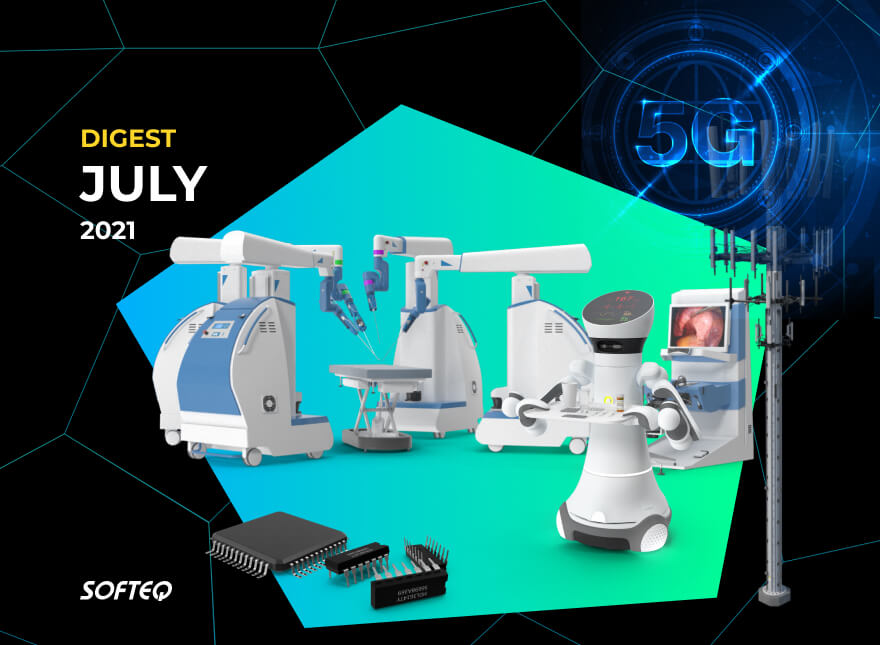This is What Techies Talked About in July

In this issue of the Tech Digest: new AI software helps engineers innovate in a matter of 30 minutes, the global chip shortage remains, and not just because of COVID-19, and AI technology detects early signs of prostate cancer. All that and more in a 10-minute read.
A New AI-enabled Software Suite Helps Automate Innovation Processes
Imagine if you could skip the many hours it takes to solve complicated engineering issues, and instead find a novel solution in just 30 minutes. Of course, this would save time and give you the solution. But what if the solution also came with all the necessary intellectual property (IP) documentation as well? Too good to be true? Now it's possible.
IP.com, a USA-based natural language processing engine creator, has recently introduced its latest suite of workflow solutions named IQ Ideas Plus, which makes it easy for inventors to submit, refine, and collaborate on ideas that are then delivered to the IP team for review. Find out how the solution works, and the benefits.
Is the Chip Shortage Only Driven by the COVID-19 Pandemic?
By now you’ve undoubtedly heard all the complaining about electronic parts shortages, particularly from gamers who can’t get modern GPU cards, and from car makers, as new cars are essentially computers on wheels. The reason for the shortage, both consumer and corporate, has been blamed on COVID-19—but that is only one factor.
First and foremost, this is not a shortage in the traditional sense. It’s not like Taiwan can’t make chips, although a brutal drought in Taiwan is causing problems for the world’s premier chip maker. The problem is that demand is so great that existing production capacity simply can’t keep up. Read about other problems facing chip makers, and what companies can do to address this supply constraint.
This is how Scientists Trained AI to Detect Early-stage Prostate Cancer
AI made a breakthrough in healthcare. What earlier was deemed impossible, is now a reality. AI technology can now help identify early signs of cancer.
Recently, researchers from the Royal Melbourne Institute of Technology introduced exactly this AI detection model. The solution can spot early signs of prostate cancer by analyzing routine computed tomography (CT) scans. The AI model has been trained using CT scans of asymptomatic patients, with and without prostate cancer, to spot the smallest irregularities, features of the disease, and where exactly to look for them—without the need to manually crop the images. Learn more about the solution, and the next steps the team is planning to take.
A Text-to-Speech Solution that Sounds Human Now is Here
We're a couple of decades into the 21st century, cars are literally starting to fly, a vacation to space is just around the corner, and yet somehow, computers still sound like parodies of confused robots whenever they’re asked to convert text-to-speech (TTS). There has to be a better solution, right? A firm called WellSaid Labs believes it has one.
WellSaid Labs' text-to-speech became the first to achieve human parity for naturalness on short audio clips across multiple voices. Their human-parity AI voice can be produced faster than real-time and updated on-demand. Opening up new and exciting opportunities to "add voice" was never possible before. Read how this AI solution helped solve the problem of making a digitized voice sound human when converting text to speech.
Google Cloud and AT&T to Help Businesses Create New 5G Experiences
Last year Google and AT&T first said they were working together on a portfolio of 5G edge computing solutions for industries like retail, manufacturing, and transportation. This July the companies took the next step. They announced a new set of services that will help businesses build new 5G-powered applications and run them either on-premises or at the network edge.
With the first service, business customers will be able to build and run applications using Google Cloud capabilities, such as AI, Kubernetes, and data analytics. The second service will allow enterprises to deploy applications at Google edge points of presence (POPs), which will be connected to AT&T's 5G and fiber networks. Learn what opportunities these two services will bring to enterprises.
